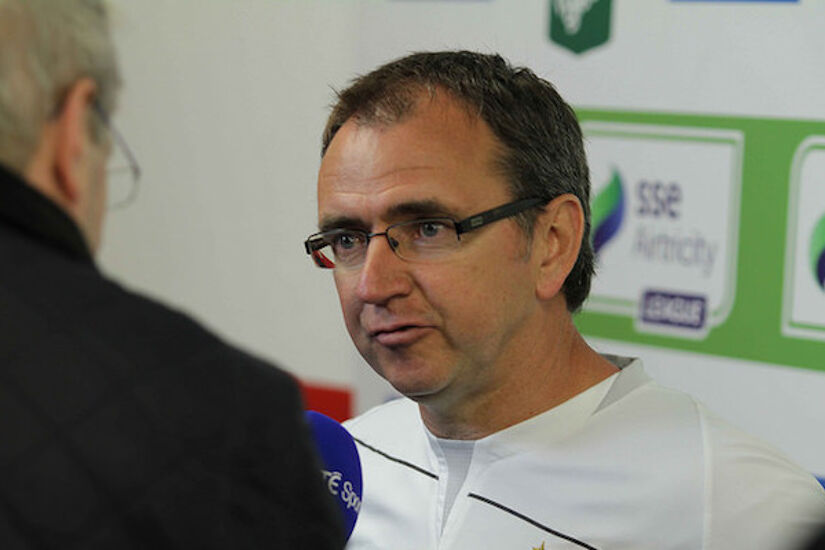Pat Fenlon Interview: To improve things so quickly, and the fortunes of the club, I take great pride in that

Credit: Michael P Ryan (ETPhotos)
As well as boasting an impressive CV on the domestic front, both on and off the field, Pat Fenlon has won silverware in the Irish League, managed the Republic of Ireland U23s and Scottish side Hibernian, while a Director of Football role at Waterford FC can also be added to the list.
Returning home to Dublin in 1987, following a youth career at Chelsea, Pat joined Brian Kerr’s St. Patrick’s Athletic, capturing the Premier Division title during the 1989/90 campaign. Two seasons later, the young midfielder arrived at Bohemians, where he lifted the FAI Cup, was named as PFAI Player of the Year and scored in a B international against Denmark, all in the same year.
“It’s just one of those points in your career when everything goes right,” said Fenlon when extratime.ie caught up with him recently to chat about his extensive career in football. “That was a time when I really enjoyed my football.”
Seeking a new challenge in early 1994, Fenlon became the first Dublin-born Catholic to sign for Linfield and he went on to play a major part in two IFA Cup successes and an Irish Premier League win for the Blues.
“It was common knowledge that I was leaving Bohs and Linfield came in. There were obviously doubts about whether it was the right move to make, with the history and background of the club. A Dublin Catholic going to play for Linfield was a big step to take, but it was the best move I made throughout my career.
"It was a fantastic club to play for and I enjoyed my time there. In 1994, the Troubles had just ended and everybody would have had doubts in regards to going there.”
A solitary season (1996/97) at Shamrock Rovers preceded a lengthy spell with Shelbourne, where Pat won the double and a second PFAI Player of the Year award for the 1999/00 campaign. Appointed as player/manager in 2002, like most entrusted with this dual role, Fenlon soon stepped away from the former to concentrate on the latter.
“When I got the Shels job initially, I did it for three or four games. I stopped playing after that because it’s impossible to do both. I put myself in the position that when I was playing and things weren’t going well, it’s more difficult to change things than if you were on the bench. You’re preparing yourself for games, as a player, and as a manager you have to get the rest of the squad ready also.”
Pat went on to guide the Reds to three Premier Division titles in four years and also embarked onan incredible run in the 2004/05 UEFA Champions League qualifiers, eventually bowing out to Spanish side Deportivo de La Coruna.
“It was something to be embraced and not a distraction. The hardest games we had were both against Reykjavik. People expected us to get through that one and we did, but on away goals only … Anything after that was bonus territory. We didn’t realise how big a deal the Deportivo games were going to be. A sell-out at Lansdowne Road was a fantastic achievement.”
Resigning the Tolka Park hot seat at the end of 2006, Fenlon became Derry City’s new manager, only to depart Foyleside less than half a year after accepting the position.
“I don’t think there was too much needed to turn the club around, as they had a very good manager in Stephen Kenny before I arrived. I turned the Derry job down three or four times and should have stuck with my gut feeling. Eventually, I went up there, but things didn’t work out and sometimes that happens at a football club.
"After five months, I realised that it wasn’t going to be good for me or the club, so I walked away. I shook people’s hands and knew that I needed to follow a different path. No regrets, as I wasn’t entirely comfortable in the job.”
While still in charge of the Republic of Ireland U23s, Pat became Bohemians boss. He led the club to their second double in a decade at the first time of asking, in 2008. That year’s Premier Division winning margin of 19 points still a record.
“We had such talented players and a big enough squad that the level of performance had to be good to stay in the team. We were on such a good run that to achieve the double was enough motivation to keep people going. You set your standards throughout the season, no matter what happens.”
Back-to-back league titles and the League of Ireland Cup the following season, with the 2010 Setanta Sports Cup thrown in for good measure, all came before the Gypsies’ financial problems and the end of Fenlon’s tenure.
With his stock high, the Dublin native became Hibernian’s new manager in late 2011, but despite successive Scottish Cup final appearances and relegation avoidances, the pressure and expectations of guiding an SPL side were at a different level.
“The media intensity in Scotland is huge. Football’s such a popular sport there and Hibernian are a big club. Fabulous job, loved my time over there, but the fervour is much more than in Ireland. Some good times, some bad, but a brilliant experience and a massive privilege to manage the club.”
Subsequent to Pat’s resignation, he managed Shamrock Rovers until 2016 and then became Waterford FC’s Director of Football under chairman Lee Power, departing this past February.
“When you get to the stage where I am, with management, you’re open to other roles. At Waterford, it gave me an opportunity to see a whole different side of how a club is run, not just with what happens in games. The key to Waterford was after Lee asked me to go in and get involved, it was at a really low ebb.
"To turn things around there was extremely satisfying, in relation to what was happening both on and off the pitch. To improve things so quickly, and the fortunes of the club, I take great pride in that.”

